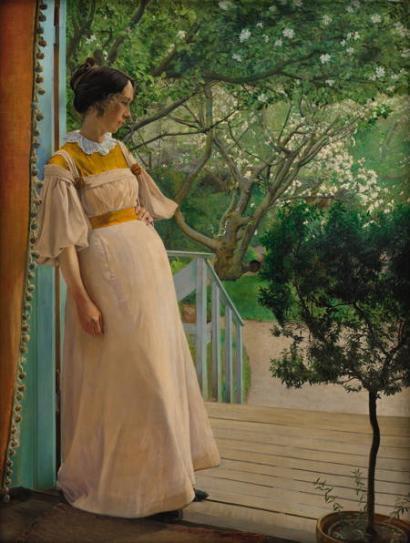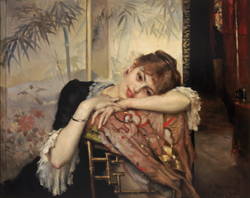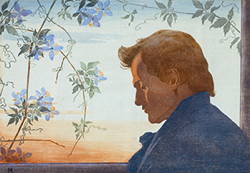
L.A. Ring, At the French Windows. The Artist's Wife, 1897. Oil on canvas, 198,5 x 153,2 cm, Statens Museum for Kunst, © SMK Photo. |
|
STATENS MUSEUM FOR KUNST COPENHAGEN
Sølvgade 48-50
DK-1307 København K
INFORMATION
• Phone: +45 3374 8494
• Fax: +45 3374 8404
• Website: www.smk.d
• Email: smk@smk.dk
OPENING HOURS
• Monday: Closed
• Tuesday-Sunday: 11.00 -17.00
• Wednesday: 11.00 - 20.00
ADMISSION FEES
• Adults: DKK 110
• Under 30: DKK 85
• Under 18: Free
• 1 adult + 1 child: DKK 90
• Annual pass holders: Free
• Groups (10+): DKK 100 per person
PRESS CONTACT
Head of Press
Karen Ormstrup Søndergaard
• Phone: +45 2552 7203
• Email: kos@smk.dk

|
Mount Fuji covered in snow, cherry trees in blossom and “The Great Wave”: in the second half of the nineteenth century a wave of enthusiasm for all things Japanese crashed across the Western world – a Japanomania.
 Albert Edelfelt, Virginie, 1883. Oil on canvas, 73,5 x 92,5 cm, Arla Cederberg Collection, Joensuu Art Museum, photo: Hyttinen, Kari.
One of the best-known and best-loved paintings in the SMK collections is Laurits Andersen Ring’s The Artist’s Wife. L.A. Ring painted this declaration of love to Sigrid Kähler in 1897, and in addition to portraying the artist’s wife in a moment of bliss the work also exemplifies how Japanese influences left their mark on Nordic art: the garden may be Danish, but shown full of decorative blossoming trees with gnarled branches as in Japanese art, and the woman herself is captured in a Zen-like moment of calm. With the exhibition Japanomania in the North 1875–1918 SMK turns back time to show how Western art became infused by Japanese aesthetics: asymmetrical compositions, decorative subject matter, meditative imagery and close observation of birds, fish, insects, branches and flowers. This is the first exhibition ever in Denmark to demonstrate the impact of Japonisme on Nordic art.
How Japan reached Europe
The influence from Japan was particularly strong on artists such as Claude Monet, Edvard Munch, van Gogh, Vilhelm Hammershøi, Anna Ancher, Albert Edelfelt and L.A. Ring, all of whom are featured in the exhibition. Many of the artists who were swept up by the craze for all things Japanese also staged themselves and their families in silk kimonos, fans, parasols and paper lamps, using photographs to immortalise themselves as Japonistes – either at their studios or in their own homes, decorated in the Japanese style. Japan had been largely isolated and inaccessible to the Western world from the 1630s until around 1853, when the country opened its borders to allow international trade. This gave Europe access to Japanese goods and art. The “new” objects were featured at a range of world’s fairs, and the term “Japonisme” was coined to describe the wave of art and applied art inspired by Japanese aesthetics.
 Henriette Christine Hahn-Brinckmann, At Sunset-a Portrait of the Danish Sculptor Niels Hansen Jacobsen, 1900-04. Woodcut, 37,8x53,5 cm. All rights reserved by Vejen Art Museum. Photo: Pernille Klemp.
With Denmark as the main conduit, Japonisme arrived slightly later in the Nordic countries than in e.g. France and England. Japanese woodcuts in particular became a major source of inspiration, offering artists a different way of looking at the nature that surrounded them. The artist and art critic Karl Madsen (1855-1938) was a key figure in the introduction of Japanese art in the Nordic countries. In 1885 he published the book Japansk Malerkunst (Japanese Painting). Being the first book on the subject in a Nordic language, it became very influential among artists and collectors. The exhibition is a collaborative effort created by the national galleries in Helsinki, Oslo and Copenhagen.
CATALOGUE
• Japanomania in the Nordic Countries, 1875-1918, edited by Gabriel P. Weisberg, Anna-Maria von Bonsdorff, and Hanne Selkokari, Yale University Press, 2016, 296 pages.
|










